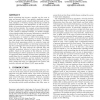124
click to vote
ACSAC
2010
IEEE
14 years 4 months ago
2010
IEEE
We present a quantitative lower bound on the number of vulnerable embedded device on a global scale. Over the past year, we have systematically scanned large portions of the inter...
127
Voted
ACSAC
2010
IEEE
14 years 4 months ago
2010
IEEE
In this work we show that once a single peer-to-peer (P2P) bot is detected in a network, it may be possible to efficiently identify other members of the same botnet in the same ne...
ACSAC
2010
IEEE
14 years 4 months ago
2010
IEEE
ACSAC
2010
IEEE
14 years 9 months ago
2010
IEEE
125
Voted
ACSAC
2010
IEEE
14 years 9 months ago
2010
IEEE
Heap spraying is an attack technique commonly used in hijacking browsers to download and execute malicious code. In this attack, attackers first fill a large portion of the victim...
113
click to vote
ACSAC
2010
IEEE
14 years 10 months ago
2010
IEEE
Twitter is a new web application playing dual roles of online social networking and micro-blogging. Users communicate with each other by publishing text-based posts. The popularit...
135
click to vote
ACSAC
2010
IEEE
14 years 10 months ago
2010
IEEE
Social networking has become a popular way for users to meet and interact online. Users spend a significant amount of time on popular social network platforms (such as Facebook, M...
128
Voted
ACSAC
2010
IEEE
14 years 10 months ago
2010
IEEE
Graphical passwords have been proposed to address known problems with traditional text passwords. For example, memorable user-chosen text passwords are predictable, but random sys...
127
click to vote
ACSAC
2010
IEEE
14 years 10 months ago
2010
IEEE
Research on network intrusion detection has produced a number of interesting results. In this paper, I look back to the NetSTAT system, which was presented at ACSAC in 1998. In ad...
99
Voted
ACSAC
2010
IEEE
14 years 10 months ago
2010
IEEE
A promising method for the detection of previously unknown code injection attacks is the identification of the shellcode that is part of the attack vector using payload execution....




